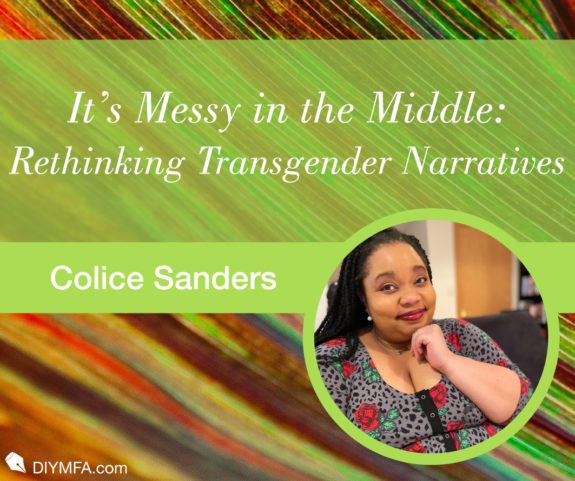Welcome back to It’s Messy in The Middle, where we reflect on ways to craft complex characters and build dynamic worlds that readers with underrepresented identities can connect with. For the past year, I have been anxiously sitting on the sidelines, trying to determine if I should address gender identity in this column. While I desperately want to see more evolved representations of transgender, genderqueer, and gender non-binary characters in literature, I want to see them come from the gender non-conforming community.
As a cisgender person who has only truly known and loved a handful of gender non-conforming people, I have been reluctant to center my voice on how to write about gender identity. It is not a topic I feel I should be taking up space to talk about, however, after learning that over the last five years, cis authors have somehow cornered the market on writing trans narratives in fiction, I realized that it was time for me to speak up.
Put me in, coach!
For most cis authors, our initial understanding of trans identity has been fueled by cisgender privilege, Christian upbringings, and decades of media misrepresentation. Therefore, it’s reasonable to assume that there are remnants of transphobia, trans misogyny, and cis sexism still coursing through our veins. These biases have the potential to reveal themselves in unintended ways when attempting to write about gender identity, which can lead to real-world consequences for gender non-conforming communities.
I want to assume that most cis authors who attempt to write trans characters do so in the spirit of inclusion and a desire to affirm trans people, but it’s alarming to realize that the majority of published and acclaimed novels about trans identity have been written by cisgender authors. These novels are then consumed by cisgender readers who accept them as gospel instead of recognizing that they are clumsily written transition fantasies that have been shoehorned into the Cinderella story.
Bibbidi-Bobbidi-Stop It!
Cinderella is the perfect analogy for understanding trans narrative tropes. It starts with Cinderella, or better yet, Transition-ella, who finds themselves struggling to be accepted by their family and community. Since Transition-ella is a trans person, they are put through gratuitous violence, shame, and suffering, without addressing the systems in place that fuel anti-trans violence. Transition-ella’s suffering ends when their cisgender fairy godmother shows up to teach them how to be a “real” woman or man. Cue the voyeuristic montage of gender bootcamp that culminates in the achievement of hyper-femininity or hyper-masculinity (you can only choose one). This enables Transition-ella to achieve the ultimate goal of hetero romantic love, and they live happily (hidden) ever after in an unchanged anti-trans world. I feel my eye twitching.
Life Beyond Gender Transitions
By solely focusing on the “before” and “after” of transgender identity, this type of narrative can border on fetishism. I certainly do not mean to suggest that family and community acceptance, violence, trauma, and transitioning are not realistic themes, because they are. However, I am frustrated that they have become so formulaic that they have begun to reinforce the very transgender stereotypes those same authors set out to work against.
I believe that when cisgender authors incorporate trans and gender non-binary perspectives in their work purely for personal gain, without credible research, or compensating, and acknowledging members of the community, they are engaging in cultural appropriation. We don’t have to look far to find several members from gender non-conforming communities begging cisgender authors to stop engaging in these tactics. To read about my views on cultural appropriation, read my last column It’s Messy In the Middle: Unpacking Cultural Appropriation.
The Messy Middle of Gender Identity
While I still believe there should not be limits placed on art, expression, creativity, or imagination, I also believe that there are stories that we have to recognize are not ours to tell, especially when the stakes are so high. Within the US, trans women continue to be murdered and assaulted at alarming rates. Trans people continue to struggle in their fight for civil rights, access to healthcare, and basic survival. Do you believe that you can craft a character in the messy middle of gender identity? Can you make visible all the invisible ways that gender identity functions as a system of power and privilege in our lives? Can you craft worlds that include trans joy, resilience, and courage while facing insurmountable odds? If you have answered a resounding yes to each of these questions, I look forward to reading your work, and please be prepared to be held accountable.

Colice Sanders is a blogger and motivational speaker. Colice writes YA, poetry, and memoir. Her blog areasontorise.com chronicles her journey of radical self-acceptance through the lens of childhood trauma. You can reach her on Facebook, Twitter, or Instagram!







